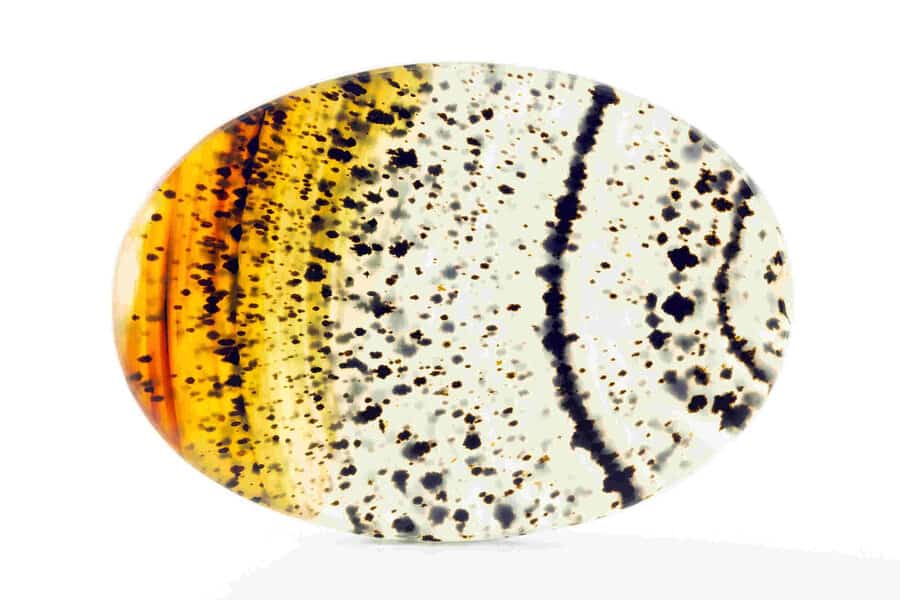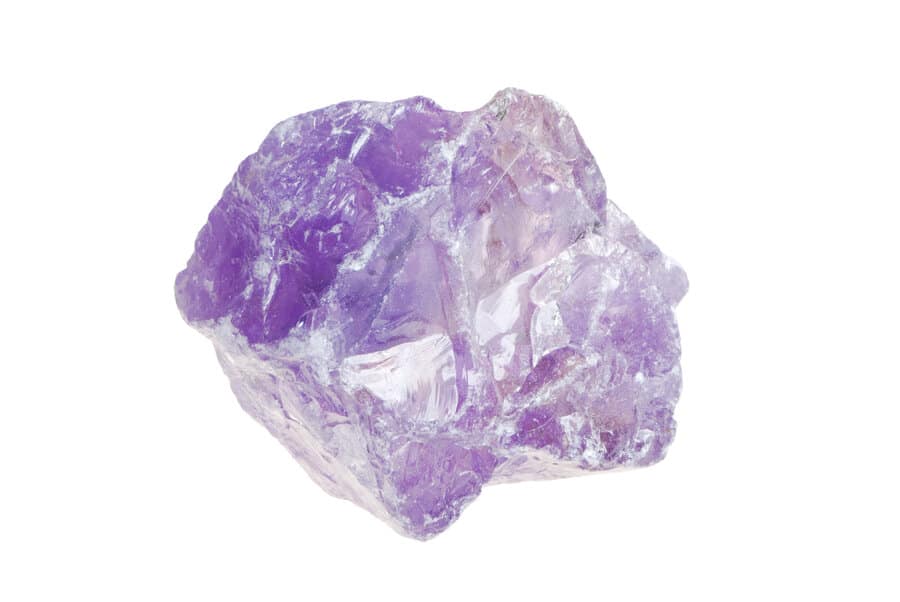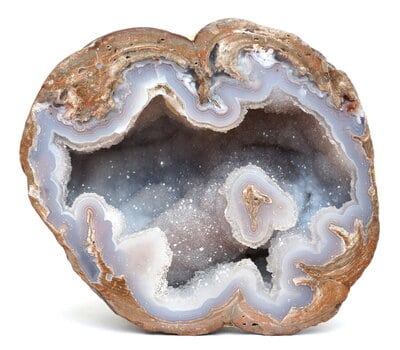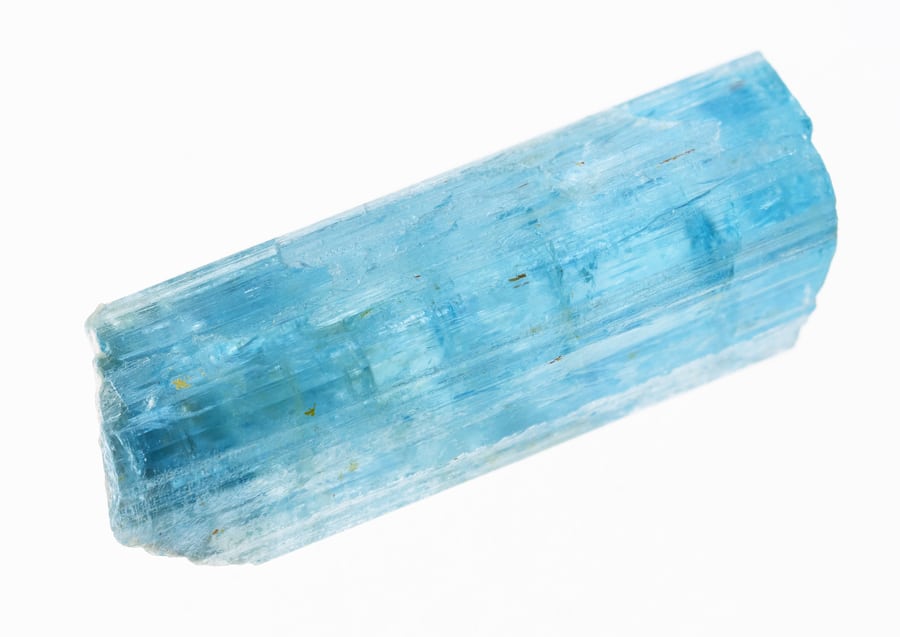Montana is definitely on the shortlist of must-visit states for rock and mineral collectors. The expansive and impressive landscape promises an adventure wherever you go, so it’s no wonder that rockhounding is an extremely popular hobby here.
The geology of Montana is dominated by relatively recent volcanic activity in the west, which is largely responsible for the wide variety of interesting rocks and minerals to be found here. The subsequent erosion by major rivers like the Jefferson and Yellowstone have transported agates and other minerals to localities all across the landscape, meaning you can find something interesting almost anywhere you look.
Montana was once a top producer of gold and other precious metals, and gold panning remains a popular hobby to this day. You can pan for gold in almost any stream or river and end the day with a nice reward of small gold flakes.
In addition to precious metals, Montana is now famous for gemstones like amethyst and sapphire which can primarily be found out west, particularly in Lewis and Clark County. But the state is probably best known for its ‘Montana Moss Agate’, which is a usually clear variety of agate with dark inclusions. These rocks make for great cabbing material and are extremely popular with collectors.
In general, the best places to rockhound in Montana are the gravels of the Yellowstone and Jefferson Rivers and their tributaries. Many private and public mines in western Montana such as the Spokane Bar Sapphire Mine and Crystal Park are also extremely popular destinations for rock collectors.
| State Symbols | |
|---|---|
| State Mineral | — |
| State Rock | Montana Agate |
| State Gemstone | Sapphire |
| State Fossil | Duck-billed dinosaur |

This article will dive deeper into the many great rockhounding sites across the state (along with maps), but I’d like to highlight a few standouts here. Here are 10 of the best rockhounding sites for rocks and minerals in Montana:
- Crystal Park – Amethyst, Quartz crystals
- Gem Mountain Sapphire Mine – Sapphire
- Jefferson River – Agate, Chalcedony, Jasper
- American Bar – Sapphire, Garnet, Kyanite
- Yellowstone River, Custer County – Moss Agate
- Pryor Mountains – Agate, Geodes, Fossils
- Spokane Bar Sapphire Mine – Gold, Sapphire
- Livingston – Agatized wood, Moss Agate
- Fallon – Montana Moss Agate
- South Boulder River – Quartz crystals
Rocks and Minerals Found in Montana
One of the biggest reasons rockhounds flock to Montana is the wide variety of rocks and minerals that can be found here. Most collectors are primarily interested in Montana Moss Agates, amethyst, and, of course, the sapphires that can be found in some privately operated mines.
Montana has a long history of mining for precious gemstones, as well as precious metals like gold and silver. In addition, you can also find many semiprecious stones scattered across the landscape. Quartz-family minerals like agates, jasper, chalcedony, and petrified wood can be found in relative abundance if you know where to look.
There is almost no limit to the number of rock and mineral species you can find in Montana, although some are obviously rarer than others. What types of rocks and minerals you can find will largely depend on where you are looking, especially considering the sheer size of the state and how varied its surface geology is.
The most commonly found and collected rocks and minerals in Montana are:
- Agate
- Amethyst
- Pyrite
- Quartz Crystals
- Sapphire
- Garnet
- Petrified wood
- Ruby
- Corundum
- Opal

If you’ve already found a rock and you’re not sure what it is, I would highly recommend checking out my Practical Rock Identification System. This bundle of information includes a book, videos, and online tools. It is, simply put, the most comprehensive and easy-to-understand rock identification system you’ll find anywhere.
You can also read through my free rock identification guide and mineral identification guide which are filled with useful information and tools.
Rockhounding Sites in Montana
Important Disclaimer: I have not been to these locations myself, and I do not know if they are currently open for collecting. Use this resource as a guide to get you started. Follow posted signage and always get permission from the landowner to collect.
Through quite a bit of research and cross-referencing of available literature, I have compiled this list of some prospective locations in Montana which I would recommend to people looking to do some rockhounding. These are mostly comprised of old mining prospects, washes, streams, and historically known rock and mineral collecting sites. For additional reading, I’d highly recommend these books you can find on Amazon:
Please remember that rock collecting locations are constantly changing. Specimens may become depleted from other collectors, the location may have been built on or altered, locality information in literature may be inaccurate, and property ownership may have changed hands. Joining up with a local rockhounding club for a group trip can often get you access to otherwise off-limits locations like privately owned mines and quarries. There are many rockhounding clubs in Montana so you can most likely find one you like nearby.
I have tried to take care not to list locations within National Park boundaries since collecting is illegal there, but please remember that it is up to you to make sure you have permission to collect wherever you are. There is plenty of BLM and National Forest land to collect on in Montana which is, in general, open for public use. Still, there may be privately owned mining claims inside those boundaries and you’ll need to get permission to collect on that location.
Though there are many locations listed here, this list is far from exhaustive. A location’s listing here is not a guarantee of accuracy. Be safe, never go underground, and make sure to get permission from the landowner to search for and collect specimens.
If you’re planning on heading to the field, make sure you have all the gear you’ll need! To get started, you can check out my recommended gear page which contains my full reviews for every Geologist’s favorite rock hammer and the best hiking backpack I’ve ever owned.
Western Montana Rockhounding Sites
Western Montana is incredibly rich in rocks and minerals and makes for a veritable playground for rockhounds and amateur collectors. You can find almost anything you might have your heart set on collecting out here, including amethyst, quartz crystals, gold, petrified wood, and many more beautiful rocks and minerals.
Most of the best rockhounding locations in western Montana are in the tailings of old mines and prospects. This part of the state has a long history of mining precious metals, ores, and gemstones, and you can still pick through the tailings to find worthwhile specimens.
In addition to the old mines, you can easily spend all day picking through the gravels of local streams, washes, and draws looking for more common (but no less interesting) minerals like agate, petrified wood, and quartz crystals.
Central Montana Rockhounding Sites
Central Montana is home to some of the best rockhounding in the entire country and has long been on the short list of ‘must visit’ destinations for collectors. The quality and diversity of the rocks and minerals is hard to beat, and the abundance of publicly owned land makes it relatively easy to get out and do some collecting.
As with the rest of the state, you can find quartz family minerals like agates and petrified wood in many area stream gravels river beds. However, the highlight for rockhounds will likely be sapphires which can be found in places like Magpie Gulch and in some specific bars of the Yellowstone River.
For a more controlled, family-friendly rockhounding environment where you are almost guaranteed to find something to add to your collection I would recommend checking out the Spokan Bar Sapphire Mine.
I would also specifically point you towards the Pryor Mountains, south of Billings. This area is well known for agates, petrified wood, and jasper, but is also one of the only places I have found reports of geodes being found in Montana.
Eastern Montana Rockhounding Sites
In eastern Montana, you won’t find the variety of rocks and minerals that you do in much of the rest of the state. Luckily, this is by far the best place to find the famed Montana agates (sometimes called Montana moss agates).
Rockhounds have flocked to the Yellowstone River and its tributaries for hundreds of years looking for this highly attractive and valuable variety of agate. You can find it in gravels and sands all along the Yellowstone River valley, but particularly around the town of Fallon.
Eastern Montana is also a great place to find bentonite outcrops. These rock layers are clay layers consisting primarily of the ash from ancient volcanic eruptions that blanketed the entire area, and therefore can be found extensively all over this part of the state.
| Location | Rocks & Minerals |
|---|---|
| Custer County, in gravels along entire length of Yellowstone River | Agate (‘Montana agate’) |
| Hysham, in hills to S | Agate (moss agate) |
| Glendive, all area gravels and washes | Agate, Jasper, Opal (moss opal) |
| Cracker Box Creek, in gravels | Agate (‘Montana agate’, gem-quality) |
| Alzada, in regional deposits & exposures | Bentonite |
| Hatchet Creek, in gravels | Agate (‘Montana agate’, gem-quality) |
| Sand Creek, in gravels | Agate (‘Montana agate’, gem-quality) |
| Fallon, gravels of Yellowstone River and tributaries | Agate (‘Montana agate’, gem-quality) |
| Terry, all area surfaces, washes, etc. | Petrified wood, Chalcedony, Jasper |
Where to Find Geodes in Montana

Everyone enjoys the prospect of finding their very own geodes out in the wild, and it’s easy to see why. Cracking them open reminds me of opening a Kinder-Egg with a surprise toy inside. You never know what type of crystals or patterns you’re going to find inside and it makes them incredibly exciting.
Amazingly, even with all of the fantastic rockhounding locations and cool specimens to find in Montana, there are very few known geode hunting spots. You may be able to find nodules and geodes in some of the agate beds, but for the most part they are very hard to come by.
The best place to find geodes in Montana is in the gravels of Bear Canyon located in the Pryor Mountains, south of Billings. The geodes are typically lined with drusy quartz and rimmed with black and white fortification agate.
Tip: Not sure if the rock you’ve found is a geode? Check out my article about how to identify a geode.
For your best chances of finding your own geodes, you may want to expand your search radius and head to a neighboring state like Idaho or Wyoming.
Where to Find Agates in Montana

I love finding agates because you never know what sort of beautiful patterns and colors they might contain. They are some of the most popular rocks to tumble, and it’s easy to see why with their intricate banding and unique designs.
Agates also happen to be some of the most commonly collected rocks in the United States, including Montana. In fact, Montana is home to a unique and appropriately named variety called ‘Montana Agate.
Montana agates are known for being unusually transparent and are sometimes paired with carnelian. They are also a specific type of moss agate, which means they are often laced with darker minerals.
If you’re looking to start collecting rocks in Montana, agates are a great place to start. They are widespread and fairly easy to find if you have a general idea of where to look.
In general, the best places to find agates in Montana are in the gravel bars of the Yellowstone River and its tributaries, particularly along the stretch between Billings to Miles City. Agates can also be found in the Jefferson River and in washes and draws all across the state.
Tip: For more info about agates and where to find them, check out my article here.
Where to Find Crystals and Gemstones in Montana
There is nothing quite like uncovering a quartz crystal with a perfect termination or finding a beautiful agate that has been waiting in a river bank for you to come along and take it home. Gemstones are some of the most enjoyable specimens that rockhounds can find, but it’s not always easy to know where to look.
Tip: Check out my Complete Rock Tumbling Guide to make your rocks and gemstones really shine!
Luckily, Montana is a prime spot for hunting your own crystals and gemstones. The many mountain ranges and associated volcanic activity throughout the state have created a perfect geologic environment for the creation of many interesting gemstones that you can now find in countless locations across the region.

In general, the best places to find crystals and gemstones in Montana are mines that are open to the public such as the Spokane Bar Sapphire Mine, Crystal Park, and Crystal Mountain Mine. They can also be found in many pegmatites, stream gravels, and old mines throughout the state.
Tip: For a comprehensive guide to finding your own gemstones and crystals, check out my article here.
Montana Rockhounding Laws & Regulations
One of the most common questions rockhounds have is whether or not they are allowed to collect at a certain location. It is the responsibility of each rockhound to obtain permission from a landowner to search and/or collect on a piece of property.
The ownership and status of land can and does change frequently, making it impossible to document accurate information for every location on this page. However, I have compiled a list of resources here so that you may investigate and obtain permission for any locations (found here or elsewhere) for yourself.
Public Land Resources
I have written entire articles which cover the rockhounding laws and regulations for nearly every type of public land you can think of. I encourage you to check them out if you are curious about the legalities of rock and mineral collecting.
- Rockhounding on Public Land: Laws and Regulations
- Can You Collect Rocks in State Parks? All 50 States Answered
To determine what type of public land a particular location is on, I would recommend starting with Montana’s Public and Private Land Ownership Maps.
Private Land Resources
As with most states, each county in Montana will have records of who owns each piece of property. You can also usually get the landowner’s name and address by visiting the county records office. I would probably start by contacting the assessor in whatever county you’re interested in and getting whatever contact information you can for the landowner.
Sources & Further Reading
The locations and information contained in this article are primarily derived from academic papers, online resources, and other outside sources. If you would like to read some of the source material for yourself I have listed them below. The majority of these locations are my interpretation of Robert Beste’s A Location Guide for Rock Hounds in the United States. Other sources include:
